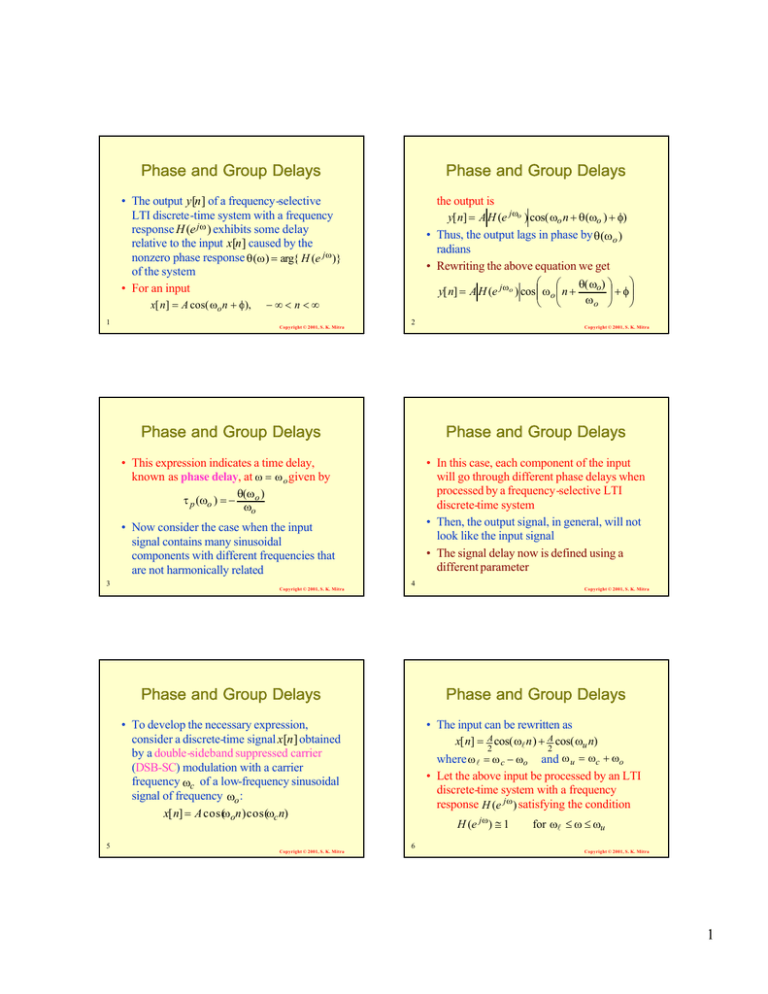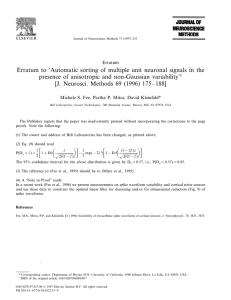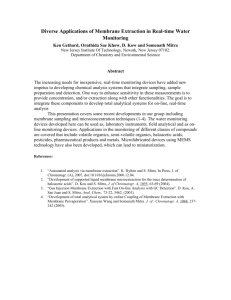Phase and Group Delays
advertisement

Phase and Group Delays
Phase and Group Delays
• The output y[n] of a frequency-selective
LTI discrete-time system with a frequency
response H (e jω ) exhibits some delay
relative to the input x[n] caused by the
nonzero phase response θ (ω ) = arg{ H (e jω )}
of the system
• For an input
x[ n] = A cos( ωo n + φ),
1
the output is
y[ n] = A H (e jωo ) cos( ωo n + θ (ωo ) + φ)
• Thus, the output lags in phase by θ (ωo )
radians
• Rewriting the above equation we get
θ( ωo)
y[ n] = A H (e jωo ) cos ω o n +
+ φ
ω o
−∞< n<∞
Copyright © 2001, S. K. Mitra
2
Phase and Group Delays
Phase and Group Delays
• This expression indicates a time delay,
known as phase delay, at ω = ω o given by
θ(ω o )
τ p (ωo ) = −
ωo
• In this case, each component of the input
will go through different phase delays when
processed by a frequency-selective LTI
discrete-time system
• Then, the output signal, in general, will not
look like the input signal
• The signal delay now is defined using a
different parameter
• Now consider the case when the input
signal contains many sinusoidal
components with different frequencies that
are not harmonically related
3
5
Copyright © 2001, S. K. Mitra
Copyright © 2001, S. K. Mitra
4
Copyright © 2001, S. K. Mitra
Phase and Group Delays
Phase and Group Delays
• To develop the necessary expression,
consider a discrete-time signal x[n] obtained
by a double-sideband suppressed carrier
(DSB-SC) modulation with a carrier
frequency ωc of a low-frequency sinusoidal
signal of frequency ωo :
x[ n] = A cos(ωon ) cos(ωc n)
• The input can be rewritten as
x[ n] = A cos( ωl n ) + A cos( ωu n)
2
2
where ω l = ω c − ωo and ω u = ωc + ωo
• Let the above input be processed by an LTI
discrete-time system with a frequency
response H (e jω ) satisfying the condition
Copyright © 2001, S. K. Mitra
H (e jω ) ≅ 1
6
for ωl ≤ ω ≤ ωu
Copyright © 2001, S. K. Mitra
1
Phase and Group Delays
Phase and Group Delays
• The output y[n] is then given by
y[ n] = A cos(ω l n + θ (ωl ) ) + A cos( ωu n + θ(ω u ))
2
• However, the two components have
different phase lags relative to their
corresponding components in the input
• Now consider the case when the modulated
input is a narrowband signal with the
frequencies ωl and ωu very close to the
carrier frequency ωc , i.e. ωo is very small
2
θ (ωu ) + θ(ωl )
θ(ωu ) − θ(ωl )
= A cos ωcn +
cos ωon +
2
2
• Note: The output is also in the form of a
modulated carrier signal with the same
carrier frequency ω c and the same
modulation frequency ωo as the input
7
Copyright © 2001, S. K. Mitra
8
Phase and Group Delays
Phase and Group Delays
• In the neighborhood of ωc we can express
the unwrapped phase response θ c (ω)as
d θ ( ω)
θ c (ω) ≅ θc (ωc ) + c
⋅ (ω − ωc )
dω ω=ωc
9
11
by making a Taylor’s series expansion and
keeping only the first two terms
• Using the above formula we now evaluate
the time delays of the carrier and the
modulating components
Copyright © 2001, S. K. Mitra
Copyright © 2001, S. K. Mitra
• In the case of the carrier signal we have
θ (ω ) + θ c (ωl )
θ (ω )
− c u
≅− c c
2 ωc
ωc
which is seen to be the same as the phase
delay if only the carrier signal is passed
through the system
10
Copyright © 2001, S. K. Mitra
Phase and Group Delays
Phase and Group Delays
• In the case of the modulating component we
have
θ (ω ) − θ c (ωl )
dθ ( ω)
− c u
≅− c
ωu − ωl
d ω ω= ωc
• The parameter
dθ ( ω)
τ g ( ωc ) = − c
dω ω= ωc
is called the group delay or envelope delay
caused by the system at ω = ωc
• The group delay is a measure of the
linearity of the phase function as a function
of the frequency
• It is the time delay between the waveforms
of underlying continuous-time signals
whose sampled versions, sampled at t = nT,
are precisely the input and the output
discrete-time signals
Copyright © 2001, S. K. Mitra
12
Copyright © 2001, S. K. Mitra
2
Phase and Group Delays
Phase and Group Delays
• If the phase function and the angular
frequency ω are in radians per second, then
the group delay is in seconds
• Figure below illustrates the evaluation of
the phase delay and the group delay
13
Copyright © 2001, S. K. Mitra
• Figure below shows the waveform of an
amplitude-modulated input and the output
generated by an LTI system
14
Phase and Group Delays
Phase and Group Delays
• Note: The carrier component at the output is
delayed by the phase delay and the envelope
of the output is delayed by the group delay
relative to the waveform of the underlying
continuous-time input signal
• The waveform of the underlying continuoustime output shows distortion when the group
delay of the LTI system is not constant over
the bandwidth of the modulated signal
15
Copyright © 2001, S. K. Mitra
Copyright © 2001, S. K. Mitra
• If the distortion is unacceptable, a delay
equalizer is usually cascaded with the LTI
system so that the overall group delay of the
cascade is approximately linear over the band
of interest
• To keep the magnitude response of the parent
LTI system unchanged the equalizer must
have a constant magnitude response at all
frequencies
16
Copyright © 2001, S. K. Mitra
Phase and Group Delays
Phase and Group Delays
• Example - The phase function of the FIR
filter y[ n] = α x[n ] + β x[n − 1] + α x[n − 2]
is θ (ω ) = −ω
• Hence its group delay is given byτ g ( ω) = 1
verifying the result obtained earlier by
simulation
• Example - For the M-point moving-average
filter
1 / M , 0 ≤ n ≤ M −1
h[n ] = 0,
otherwise
the phase function is
M/2
(M − 1)ω
2π k
θ (ω) = −
+ π ∑ µ ω −
2
M
k =0
• Hence its group delay is
τ g ( ω) = M2−1
17
Copyright © 2001, S. K. Mitra
18
Copyright © 2001, S. K. Mitra
3
Frequency Response of the
LTI DiscreteDiscrete- Time System
Frequency Response of the
LTI DiscreteDiscrete- Time System
• The convolution sum description of the LTI
discrete-time system is given by
y[ n] =
• Or,
∞
∞
Y ( e jω ) = ∑ h[ k ] ∑ x[l ] e − j ω( l+ k )
l =−∞
k =−∞
∞
∑ h[k ] x[n − k]
k =−∞
∞
∞
= ∑ h[ k ] ∑ x[l] e − j ω l e − jω k
k =−∞
l =−∞
• Taking the DTFT of both sides we obtain
∞
Y ( e jω ) = ∑ y[ n] e− jω n
n= −∞
∞ ∞
19
= ∑ ∑ h[ k ] x[ n − k ] e− jω n
Copyright © 2001, S. K. Mitra
n = −∞ k =−∞
X ( e jω )
20
Frequency Response of the
LTI DiscreteDiscrete- Time System
Frequency Response of the
LTI DiscreteDiscrete- Time System
• Hence, we can write
• It follows from the previous equation
H (e j ω ) = Y ( e j ω ) / X ( e j ω )
∞
Y ( e jω ) = ∑ h[ k ] e − j ω k X ( e j ω ) = H (e j ω ) X ( e j ω )
k = −∞
• In the above H (e jω ) is the frequency
responseof the LTI system
• The above equation relates the input and the
output of an LTI system in the frequency
domain
21
Copyright © 2001, S. K. Mitra
• For an LTI system described by a linear
constant coefficient difference equation of
the form we have
H (e jω ) =
− jω k
∑M
k=0 pke
− jω k
∑kN=0 d k e
22
Copyright © 2001, S. K. Mitra
The Transfer Function
The Transfer Function
• A generalization of the frequency response
function
• The convolution sum description of an LTI
discrete-time system with an impulse
responseh[n] is given by
• Taking the z-transforms of both sides we get
y[ n] =
23
Copyright © 2001, S. K. Mitra
Y(z ) =
=
∞
∑ h[k ] x[ n − k ]
k = −∞
Copyright © 2001, S. K. Mitra
24
∞
∞
∞
∑ y[n] z −n = ∑ ∑ h[k ] x[ n − k ] z − n
n =−∞
∞
n= −∞ k = −∞
∞
∑ h[k ] ∑ x[ n − k ]z −n
n= −∞
∞
= ∑ h[ k ] ∑ x[l ]z − (l + k )
k = −∞
l =−∞
k =−∞
∞
Copyright © 2001, S. K. Mitra
4
The Transfer Function
The Transfer Function
• Or, Y ( z ) =
∞
∞
• Hence,
∑ h[ k] ∑ x[l]z − l z −k
k =−∞
l= −∞
H ( z) = Y ( z) / X ( z)
• The function H(z), which is the z-transform of
the impulse response h[n] of the LTI system,
is called the transfer function or the system
function
• The inverse z-transform of the transfer
function H(z) yields the impulse response h[n]
X (z )
• Therefore, Y ( z ) = ∑ h[k ]z − k X ( z)
k =−∞
∞
H (z )
• Thus,
Y(z) = H(z)X(z)
25
Copyright © 2001, S. K. Mitra
26
The Transfer Function
The Transfer Function
• Consider an LTI discrete-time system
characterized by a difference equation
∑
N
k =0 d k y[ n − k ] =
27
• Or, equivalently as
H ( z) = z ( N − M )
∑
M
k =0 pk x [n − k ]
• Its transfer function is obtained by taking
the z-transform of both sides of the above
equation
M
−k
∑ p z
• Thus
H ( z) = kN=0 k − k
∑k=0 dk z
Copyright © 2001, S. K. Mitra
H ( z) =
M
−1
p0 ∏ k =1(1 − ξ k z )
⋅ N
d 0 ∏ (1 − λk z−1)
Copyright © 2001, S. K. Mitra
The Transfer Function
• For a causal IIR digital filter, the impulse
response is a causal sequence
• The ROC of the causal transfer function
M
p
∏ ( z − ξk )
H ( z) = 0 z( N − M ) kN=1
d0
∏k =1 ( z − λk )
is thus exterior to a circle going through the
pole furthest from the origin
• Thus the ROC is given by z > max λ k
k =1
Copyright © 2001, S. K. Mitra
M
k =1
28
• Or, equivalently as
M
p
∏ ( z − ξk )
H ( z) = 0 z( N − M ) kN=1
d0
∏ ( z − λk )
29
M −k
∑ k = 0 pk z
N
∑ k = 0 d k z N −k
• An alternate form of the transfer function is
given by
The Transfer Function
• ξ1, ξ 2 , ... ,ξ M are the finite zeros , and
λ1, λ2, ... , λN are the finite poles of H(z)
• If N > M, there are additional( N − M ) zeros
at z = 0
• If N < M, there are additional( M − N ) poles
at z = 0
Copyright © 2001, S. K. Mitra
k
30
Copyright © 2001, S. K. Mitra
5
The Transfer Function
The Transfer Function
• The transfer function has M zeros on the
unit circle at z = e j 2πk / M , 0 ≤ k ≤ M −1
• There are M −1 poles at z = 0 and a single
M=8
pole at z = 1
• The pole at z = 1
exactly cancels the
zero at z = 1
• The ROC is the entire
z-plane except z = 0
• Example - Consider the M-point movingaverage FIR filter with an impulse response
1 / M , 0 ≤ n ≤ M −1
h[n ] = 0,
otherwise
• Its transfer function is then given by
Imaginary Part
1
1 M −1 −n
1 − z− M
zM −1
=
H ( z) =
z =
∑
−
1
M n =0
M (1 − z ) M [ z M ( z −1)]
31
Copyright © 2001, S. K. Mitra
0.5
7
0
-0.5
-1
-1
-0.5
32
0
0.5
Real Part
1
Copyright © 2001, S. K. Mitra
The Transfer Function
The Transfer Function
• Alternate forms:
z 2 − 1 .2 z + 1
z 3 − 1.3 z 2 + 1.04z − 0.222
( z − 0.6 + j 0.8)( z − 0.6 − j 0.8)
=
(z − 0.3)(z − 0.5 + j0.7)( z − 0.5 − j 0.7)
• Example - A causal LTI IIR digital filter is
described by a constant coefficient
difference equation given by
H ( z) =
y[ n] = x[n −1] − 1.2 x[ n − 2 ] + x[ n − 3] + 1 .3 y[ n − 1]
−1 .04 y[ n − 2] + 0. 222 y[ n − 3]
• Its transfer function is therefore given by
33
z −1 − 1.2 z − 2 + z− 3
H ( z) =
1 − 1.3 z −1 + 1 .04 z −2 − 0 .222 z −3
Copyright © 2001, S. K. Mitra
34
0.5
0
-0.5
-1
-1
-0.5
0
Real Part
0.5
1
Copyright © 2001, S. K. Mitra
Frequency Response from
Transfer Function
Frequency Response from
Transfer Function
• If the ROC of the transfer function H(z)
includes the unit circle, then the frequency
response H (e jω ) of the LTI digital filter can
be obtained simply as follows:
H (e jω) = H ( z) z= e jω
• For a stable rational transfer function in the
form
M
p
∏ ( z − ξk )
H ( z) = 0 z( N − M ) kN=1
d0
∏ ( z − λk )
k =1
the factored form of the frequency response
is given by
M
p
∏ ( e jω − ξ k )
H (e jω) = 0 e jω( N − M ) kN=1
d0
∏k =1 (e jω − λ k )
• For a real coefficient transfer function H(z)
it can be shown that
2
H (e j ω ) = H ( e j ω ) H * (e j ω )
35
Imaginary Part
1
• Note: Poles farthest from
z = 0 have a magnitude
0.74
• ROC: z > 0.74
= H ( e jω ) H (e− jω ) = H ( z ) H ( z −1)
z= e jω
Copyright © 2001, S. K. Mitra
36
Copyright © 2001, S. K. Mitra
6
Frequency Response from
Transfer Function
Frequency Response from
Transfer Function
• It is convenient to visualize the contributions
of the zero factor ( z − ξk ) and the pole factor
( z − λk ) from the factored form of the
frequency response
• The magnitude function is given by
M
∏ e jω − ξk
p
H (e jω ) = 0 e jω( N − M ) kN=1
d0
∏k =1 e jω − λ k
37
Copyright © 2001, S. K. Mitra
which reduces to
M
jω
p ∏ e − ξk
H (e jω ) = 0 kN=1
d0 ∏ e jω − λk
k =1
• The phase response for a rational transfer
function is of the form
arg H (e jω ) = arg( p0 / d0 ) + ω( N − M )
38
Frequency Response from
Transfer Function
2
p0
d0
2
M
Copyright © 2001, S. K. Mitra
k =1
k =1
Copyright © 2001, S. K. Mitra
• The factored form of the frequency
response
M
p
∏ ( e jω − ξ k )
H (e jω) = 0 e jω( N − M ) kN=1
d0
∏ (e jω − λ k )
∏k =1(e jω − ξ k )(e − jω − ξ*k )
N
∏k =1(e jω − λ k )(e − jω − λ*k )
39
N
Geometric Interpretation of
Frequency Response Computation
• The magnitude-squared function of a realcoefficient transfer function can be
computed using
H (e jω) =
M
+ ∑ arg( e jω − ξk ) − ∑ arg( e jω − λk )
k =1
is convenient to develop a geometric
interpretation of the frequency response
computation from the pole-zero plot as ω
varies from0 to 2π on the unit circle
40
Copyright © 2001, S. K. Mitra
Geometric Interpretation of
Frequency Response Computation
Geometric Interpretation of
Frequency Response Computation
• The geometric interpretation can be used to
obtain a sketch of the response as a function
of the frequency
• A typical factor in the factored form of the
frequency response is given by
• As shown below in the z-plane the factor
( e jω − ρ e jφ ) represents a vector starting at
the point z = ρe jφ and ending on the unit
circle at z = e jω
( e jω − ρ e jφ )
where ρe jφ is a zero if it is zero factor or is
a pole if it is a pole factor
41
Copyright © 2001, S. K. Mitra
42
Copyright © 2001, S. K. Mitra
7
43
Geometric Interpretation of
Frequency Response Computation
Geometric Interpretation of
Frequency Response Computation
• As ω is varied from0 to 2π, the tip of the
vector moves counterclockise from the
point z = 1 tracing the unit circle and back
to the point z = 1
• As indicated by
Copyright © 2001, S. K. Mitra
H (e jω) =
44
M
Copyright © 2001, S. K. Mitra
Geometric Interpretation of
Frequency Response Computation
• Likewise, from
arg H (e jω) = arg(p0 / d0 ) + ω( N − M )
jω
jω
+ ∑M
− ξk ) − ∑N
− λk )
k =1 arg(e
k =1 arg(e
we observe that the phase response
at a specific value of ω is obtained by
adding the phase of the termp0 / d 0 and the
linear-phase termω ( N − M ) to the sum of
the angles of the zero vectors minus the
angles of the pole vectors
Copyright © 2001, S. K. Mitra
∏k =1 e jω − ξ k
N
∏k =1 e jω − λ k
jω
the magnitude response|H ( e )| at a
specific value of ω is given by the product
of the magnitudes of all zero vectors
divided by the product of the magnitudes of
all pole vectors
Geometric Interpretation of
Frequency Response Computation
45
p0
d0
• Thus, an approximate plot of the magnitude
and phase responses of the transfer function
of an LTI digital filter can be developed by
examining the pole and zero locations
• Now, a zero (pole) vector has the smallest
magnitude when ω = φ
46
Copyright © 2001, S. K. Mitra
Geometric Interpretation of
Frequency Response Computation
• To highly attenuate signal components in a
specified frequency range, we need to place
zeros very close to or on the unit circle in
this range
• Likewise, to highly emphasize signal
components in a specified frequency range,
we need to place poles very close to or on
the unit circle in this range
47
Copyright © 2001, S. K. Mitra
8





